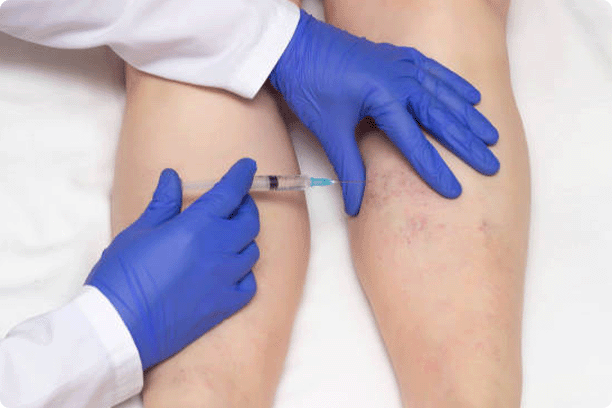Foam Sclerotherapy

At a Glance
Foam sclerotherapy uses an emulsion of the drugs used in conventional sclerotherapy. This method sees faster results across fewer treatment sessions.
Foam sclerotherapy is very useful on more extensive varicosities for which conventional sclerotherapy may be ineffective. Risks and side effects are minimal when treated by an experienced vein care professional.
The Procedure
Like conventional sclerotherapy, foam sclerotherapy works by injecting the diseased vein with a solution that promotes vein closure. Foam sclerotherapy uses an emulsion of the same drug used in conventional sclerotherapy, which appears to have a more significant effect on the inner wall of treated veins. An emulsion is created by mixing air with the conventional chemical, resulting in a foam solution. The emulsion suffers less dilution from blood because it tends to displace blood instead of simply mixing with it. As a result, the drug has far better contact with the vessel wall surface.
Foam sclerotherapy provides better results and requires less drug concentration than conventional sclerotherapy. This method usually garners faster results across fewer treatment sessions.
What Conditions Does It Treat?
Foam sclerotherapy treats patients with medium to large varicose veins and spider veins. This procedure is highly effective on larger vessels, mainly when jointly used with ultrasound-guided injections.
Traditional sclerotherapy is mostly ineffective on more extensive varicosities, but foam sclerotherapy displaces the blood, allowing for better contact between the drug and the vein walls.
Am I a Candidate?
Foam sclerotherapy is indicated for patients who want to treat varicose veins and spiders with fewer treatments than conventional sclerotherapy. Foam sclerotherapy can be used with injections guided by ultrasound or Veinlite technologies. Guidance technologies can provide more accurate treatment of the diseased vein.
Recovery
The minimally-invasive nature of foam sclerotherapy means that there will be virtually no downtime after your treatment. Patients can get up and walk around immediately after the procedure; patients are generally able to return to work the same day. Recovery includes similar post-procedural requirements to other sclerotherapy treatments, such as a short elevation, wearing compression garments, and light exercise to promote healthy circulation. Blood clots will form in the treated vein, which may look like lumps under your skin’s surface. As they heal, some tenderness and discoloration may be present.
The results of treatment will not be immediately visible. The treated vein may sometimes look darker and worse than before treatment. The darkness should fade within a week, and you will begin to see a positive outcome within several weeks.
Potential Risks
When performed by an experienced vein care specialist, there are minimal complications associated with foam sclerotherapy. Risks include those associated with conventional sclerotherapy, which are discoloration of the vein under the skin, bruising or inflammation at the injection site, and allergic reactions from ingredients in the solution.
Matting can also occur, where your body forms many tiny blood vessels around the injection site. Matting will usually resolve independently but sometimes requires additional injections to relieve.

Request a Consultation
To request a Foam Sclerotherapy consultation, fill out the form below or call us!
Walnut Creek 925-278-6001
